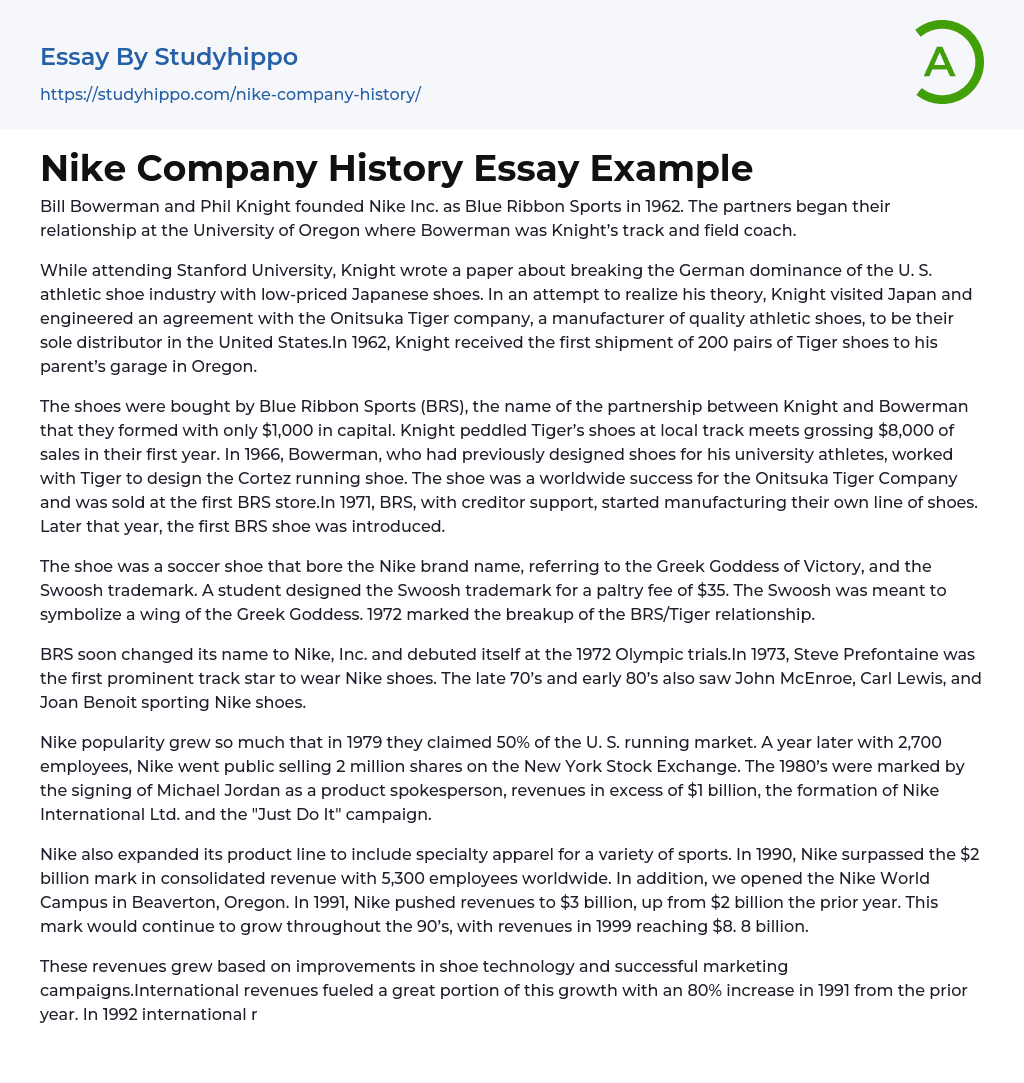Bill Bowerman and Phil Knight founded Nike Inc. as Blue Ribbon Sports in 1962. The partners began their relationship at the University of Oregon where Bowerman was Knight’s track and field coach.
While attending Stanford University, Knight wrote a paper about breaking the German dominance of the U. S. athletic shoe industry with low-priced Japanese shoes. In an attempt to realize his theory, Knight visited Japan and engineered an agreement with the Onitsuka Tiger company, a manufacturer of quality athletic shoes, to be their sole distributor in the United States.In 1962, Knight received the first shipment of 200 pairs of Tiger shoes to his parent’s garage in Oregon.
The shoes were bought by Blue Ribbon Sports (BRS), the name of the partnership between Knight and Bowerman that they formed with only $1,000 in ca
...pital. Knight peddled Tiger’s shoes at local track meets grossing $8,000 of sales in their first year. In 1966, Bowerman, who had previously designed shoes for his university athletes, worked with Tiger to design the Cortez running shoe. The shoe was a worldwide success for the Onitsuka Tiger Company and was sold at the first BRS store.In 1971, BRS, with creditor support, started manufacturing their own line of shoes. Later that year, the first BRS shoe was introduced.
The shoe was a soccer shoe that bore the Nike brand name, referring to the Greek Goddess of Victory, and the Swoosh trademark. A student designed the Swoosh trademark for a paltry fee of $35. The Swoosh was meant to symbolize a wing of the Greek Goddess. 1972 marked the breakup of the BRS/Tiger relationship.
BRS soon changed its name to Nike, Inc. an
debuted itself at the 1972 Olympic trials.In 1973, Steve Prefontaine was the first prominent track star to wear Nike shoes. The late 70’s and early 80’s also saw John McEnroe, Carl Lewis, and Joan Benoit sporting Nike shoes.
Nike popularity grew so much that in 1979 they claimed 50% of the U. S. running market. A year later with 2,700 employees, Nike went public selling 2 million shares on the New York Stock Exchange. The 1980’s were marked by the signing of Michael Jordan as a product spokesperson, revenues in excess of $1 billion, the formation of Nike International Ltd. and the "Just Do It" campaign.
Nike also expanded its product line to include specialty apparel for a variety of sports. In 1990, Nike surpassed the $2 billion mark in consolidated revenue with 5,300 employees worldwide. In addition, we opened the Nike World Campus in Beaverton, Oregon. In 1991, Nike pushed revenues to $3 billion, up from $2 billion the prior year. This mark would continue to grow throughout the 90’s, with revenues in 1999 reaching $8. 8 billion.
These revenues grew based on improvements in shoe technology and successful marketing campaigns.International revenues fueled a great portion of this growth with an 80% increase in 1991 from the prior year. In 1992 international revenues topped $1 billion for the first time and accounted for over one-third of our total revenues. Such growth continued throughout the 1990's as we continued to focus our marketing efforts on major sporting events like the World Cup, and the next generation of celebrity endorsers, such as Tiger Woods, Lance Armstrong, and the players of women's professional basketball (WNBA). At the
end of the 90’s, Nike’s goal, as stated in our company web site, is to become a truly global brand.
- Russian Empire essays
- Ancient Greece essays
- British Empire essays
- Historical Figures essays
- Nazi Germany essays
- Roman Empire essays
- War essays
- Revolution essays
- 19Th Century essays
- Historiography essays
- History of the United States essays
- 20Th Century essays
- World History essays
- Vikings essays
- Declaration of Independence essays
- Civilization essays
- Evidence essays
- Genocide essays
- Colonialism essays
- Rebellion essays
- 1960S essays
- 1920S essays
- 1950S essays
- Letter from Birmingham Jail essays
- Louisiana Purchase essays
- The Columbian Exchange essays
- World Hunger essays
- What is History essays
- Bravery essays
- Gilded Age essays
- Vladimir Lenin essays
- Alexander The Great essays
- Sparta essays
- Victorian Era essays
- Henry v essays
- Stonehenge essays
- Frederick Douglass essays
- Mahatma Gandhi essays
- Joseph Stalin essays
- Geert Hofstede essays
- George Eliot essays
- Ginevra King essays
- John Keats essays
- Siegfried Sassoon essays
- Ben jonson essays
- Billy elliot essays
- Wilkie collins essays
- John Proctor essays
- Harriet Tubman essays
- Napoleon essays




